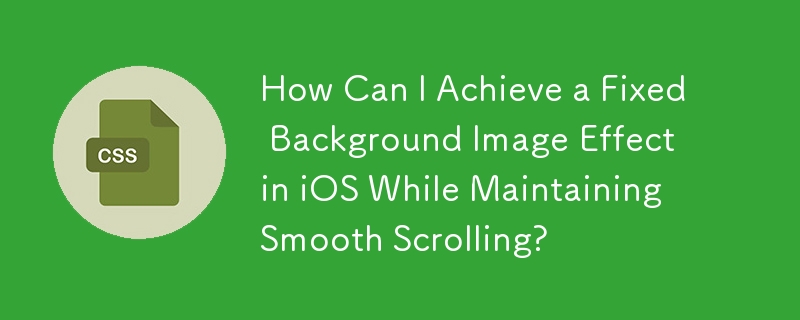Found a total of 10000 related content
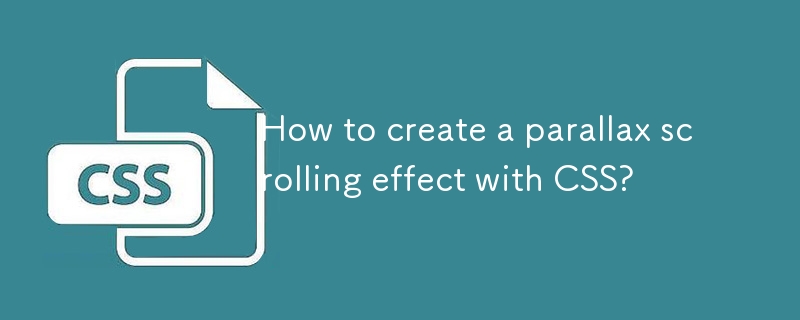
How to create a parallax scrolling effect with CSS?
Article Introduction:The parallax scrolling effect can be implemented using CSS. There are three specific methods: First, use the background-attachment attribute, set the background-attachment:fixed; make the background image fixed, forming visual misalignment; second, use transform:translateZ() and perspective to set multiple levels in HTML and give different depths to simulate the 3D scrolling effect; third, combine HTML, CSS and JavaScript, dynamically adjust the style by listening to scroll events to achieve more complex animation effects. These three methods are applicable to basic parallax, full-screen display websites and high-definition
2025-07-25
comment 0
940
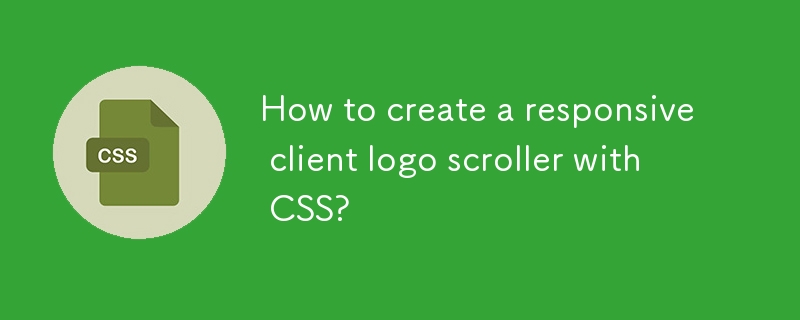
How to create a responsive client logo scroller with CSS?
Article Introduction:Use HTML to create a structure containing repeated logos to achieve seamless scrolling; 2. Use CSS animation and transform to achieve smooth horizontal scrolling; 3. Use media queries to make the logo adaptable to different screen sizes; 4. Optionally add: hover pause animation to improve user experience; 5. Optimize image format, add barrier-free tags and control the number of logos to improve performance and accessibility, and ultimately achieve a logo scrolling effect that does not require JavaScript, responsive and infinite loops.
2025-08-03
comment 0
579


Scroll to Top Using jQuery (Setup time: 2mins)
Article Introduction:Quickly create a website back to top scrolling function (set time: 2 minutes)
This guide will guide you step by step how to set up the Back to Top feature on your website. Just scroll down this page to view the demo.
Download the scrollTo plugin and include it.
Get an image (arrow or similar).
Contains the following HTML code.
Contains the following jQuery/JavaScript code to capture window scrolling and process the display of images.
It's that simple!
HTML
jQuery
This jQuery code displays the image when the user scrolls down, hides the image when scrolling up, and processes click events.
$(document).ready(funct
2025-02-24
comment 0
912
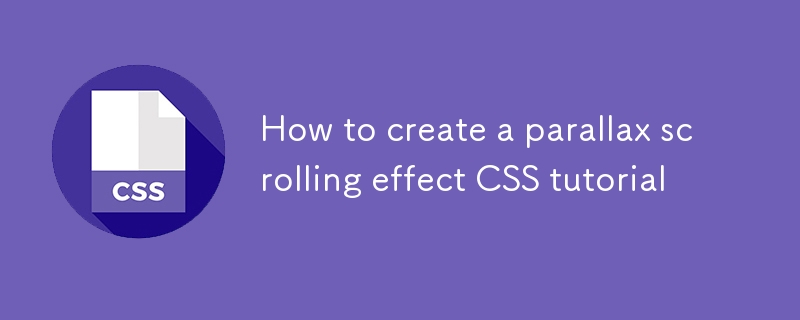
How to create a parallax scrolling effect CSS tutorial
Article Introduction:The key to making parallax scrolling effect is to allow elements of different layers to scroll at different speeds. 1. First, build a multi-layer HTML structure, including background, medium scene and foreground, and use CSS to set the container overflow:hidden and absolute positioning; 2. Then listen to scroll events through JavaScript, use transform:translateY() to dynamically adjust the positions of each layer. The background layer scrolls slowly and the medium scene is slightly faster; 3. Finally, optimize performance, use throttling functions to control the scrolling frequency, compress image resources and adapt to the mobile terminal, and consider pure CSS solutions to improve compatibility.
2025-07-04
comment 0
827

Using HTML `blink` and `marquee` (Deprecated: What to Use Instead)
Article Introduction:HTML and tags are not recommended, 1. Because they are poorly accessible, they may cause epilepsy to sensitive users; 2. Modern browsers no longer support it; 3. There is no flexible control of styles and behaviors. CSS animation should be used instead of the flickering effect, and the transparency changes should be achieved through @keyframes; 4. Use CSS or combined with JavaScript to achieve scrolling effect, such as using transform attributes to create smooth scrolling; 5. Pay attention to using animation moderately to ensure user experience and device compatibility.
2025-07-28
comment 0
163
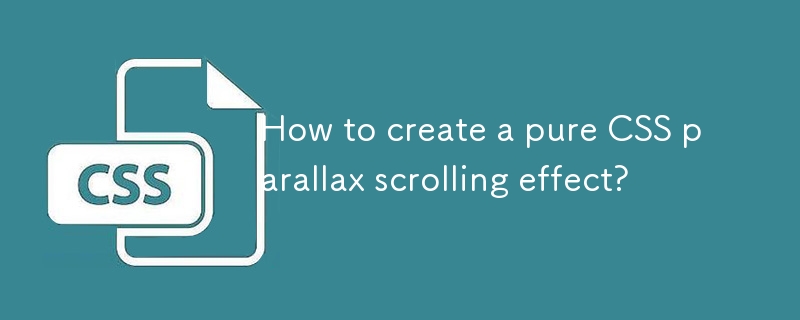
How to create a pure CSS parallax scrolling effect?
Article Introduction:Pure CSS can achieve parallax scrolling effect, mainly through background-attachment:fixed and hierarchical structure. 1. Use the background-attachment:fixed attribute to make the background image fixed, and use the background-size and background-position to realize a full-screen background, forming a visual illusion that the background is still when scrolling. 2. Create multiple blocks with different backgrounds through layered layout. Each block applies the same fixed background attribute, so that they are rendered in turn when scrolling, sandwiched between ordinary content to form multiple layers of parallax. 3. Pay attention to mobile compatibility issues, and browsers such as iOSSafari may
2025-07-25
comment 0
904

Can I Display HTML Content in CSS Content?
Article Introduction:This article explores the limitations of displaying HTML documents or fragments directly within the CSS content property. Despite this constraint, it presents creative workarounds to achieve a similar effect. These methods include utilizing SVG image
2024-10-23
comment 0
586
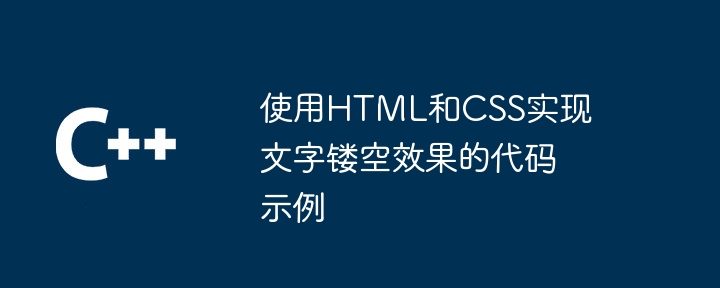
Code examples for using HTML and CSS to achieve text hollowing effect
Article Introduction:To achieve text hollowing effect using HTML and CSS, the following steps are required: Set a background image for HTML elements through the background-image attribute. Use the clip-path attribute to define the shape of the hollowed-out area, including rectangles, circles, ellipses, and polygons. Describe the specific shape of the hollow area through SHAPE-DEFINITION, for example, using circle (50% 50%, 50%) to create a circular hollow for text.
2025-04-04
comment 0
1117

How to make a parallax scrolling effect with HTML5?
Article Introduction:To realize the parallax scrolling effect in HTML5, you need to combine HTML, CSS and JavaScript. The core is to allow different page elements to scroll at different speeds. 1. The HTML structure should contain multiple independent layers, such as using different class names to represent background, intermediate content and foreground. 2. CSS uses position:absolute and translateZ to create a 3D depth sense. The smaller the value of the background layer, the slower the scrolling. 3. JavaScript can listen to scroll events, dynamically adjust the translateY value, and control the scroll speed of each layer by multiplying by a coefficient. 4. Pay attention to performance optimization and use requestAnimationFrame
2025-07-15
comment 0
735

Vanilla Javascript: Creating Animated Sticky Navigation Menu
Article Introduction:Core points
Create an animated sticky navigation menus without the need for a jQuery plugin using pure JavaScript, CSS, and HTML. The menu is designed to slide out of view when scrolling down and slide back into view with a translucent effect when scrolling up.
This process involves setting up the basic HTML structure, applying styles to main elements, and then animateing the menu. The animation is triggered by attaching the event handler to the scroll event and using CSS transformation to adjust the position and appearance of the menu according to the scrolling direction.
This custom solution provides more design flexibility and allows easy customization to be done according to specific needs. The end result is a dynamic interactive navigation menu that enhances the user experience.
Web navigation menu design needs to consider many factors, such as dishes
2025-02-16
comment 0
1164

How do you create a scrollbar in an HTML element?
Article Introduction:To create a scrollbar of HTML element, you need to control overflow behavior through CSS: 1. Set a fixed height for the element and use the overflow attribute, such as overflow:auto displays the scrollbar when needed, and overflow:scroll is always displayed; 2. You can control vertical or horizontal scrolling alone, such as overflow-y:auto only scroll vertically; 3. You can customize the scrollbar style through pseudo-elements such as::-webkit-scrollbar. Basic beautification can be achieved in Firefox, and finally, by limiting the container size and allowing the content to overflow, you can achieve the scrolling effect.
2025-08-03
comment 0
760

How to set a background image using HTML?
Article Introduction:To set HTML background images, it is mainly implemented through CSS. The common method is to use the style attribute of the body tag and control the image display effect. 1. Use the style attribute to set the background image path and alternate colors in the body tag; 2. Use background-repeat, background-size and other attributes to control the repetition, scaling and position of the image; 3. Pay attention to accessibility and performance optimization, such as ensuring text contrast and image compression. For example: At the same time, you can improve text readability by adding semi-transparent layers.
2025-07-18
comment 0
722

How does the srcset attribute help with responsive images in html?
Article Introduction:srcset is an attribute of tags in HTML that defines multiple image sources, allowing the browser to select the most appropriate image based on the device's screen size and resolution. 1. It improves page loading speed and user experience, avoiding unnecessary large image downloads or blurred displays. 2. Use the w descriptor to specify the image width. Combined with the sizes attribute, the browser can select the best image according to the layout width. 3. A pixel density descriptor such as 2x can be used to provide a clearer image for high-resolution screens. 4. When using it, src should be included as a fallback, and ensure that the image size is accurate and optimized well. Cross-device testing should be carried out to ensure the effect.
2025-07-07
comment 0
699

How to align an image to the right or left of text in HTML?
Article Introduction:To make the image line next to the text in HTML, you can achieve the following three methods: 1. Use the float attribute to achieve the text-surrounding image effect, which is suitable for traditional layouts and should be careful to clear floats; 2. Use the flexbox layout to display the image and text side by side, suitable for card-style or icon text structure in modern web pages; 3. Set text-align to control the alignment of a single line of the image through the parent container, which is suitable for scenes without text surrounding. Just choose the right method according to actual needs.
2025-07-08
comment 0
183

How does the H5 page production reflect the effect
Article Introduction:The performance of H5 pages involves all aspects, including: HTML structure, CSS style, JavaScript interaction, as well as performance optimization and best practices. In H5 code, HTML is responsible for structure, CSS is responsible for style, and JavaScript is responsible for interaction. Optimization technologies include image compression, code optimization, caching strategies, etc. to ensure user experience. In short, the H5 effect is a systematic project that requires comprehensive consideration of design, code, performance and other aspects.
2025-04-06
comment 0
556

What are tags, and what are they used for?
Article Introduction:Meta tags have four core functions in HTML pages: 1. Define basic web page information, such as character sets, authors and descriptions; 2. Control the display effect of the mobile terminal and adapt to the viewports of different devices; 3. Provide title, description and image information during social sharing; 4. Control search engine indexing behavior to determine whether the page is included or tracked links.
2025-06-22
comment 0
160
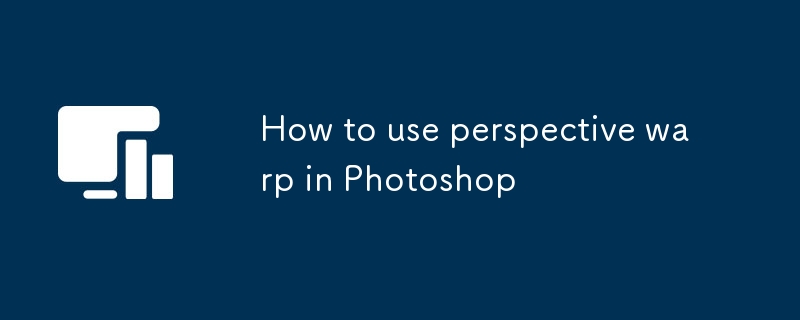
How to use perspective warp in Photoshop
Article Introduction:Use Photoshop's perspective deformation function to adjust the perspective angle of objects in the image, which is suitable for scenes such as correcting the tilt of buildings and adjusting the view angle of product pictures. 1. When starting the tool, you need to open the picture and enter "Edit>Performance Deformation". Use the mouse box to select the area to be adjusted and accurately circle the range to avoid distortion; 2. When adjusting, drag the corner points or edges to independently modify the shape. Press and hold Ctrl to adjust the surfaces to keep the lines parallel to obtain natural effects; 3. Edge gaps may occur after applying deformation. You can use content recognition filling or repair tools to manually repair to ensure that the final effect is complete and natural. Master these steps to use this function proficiently.
2025-07-16
comment 0
862




